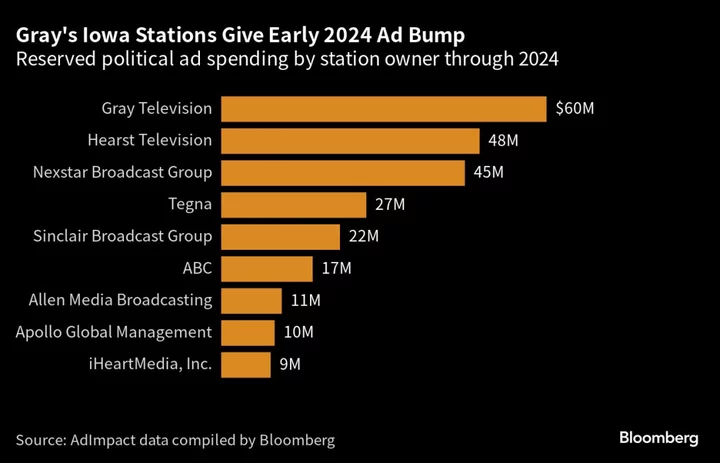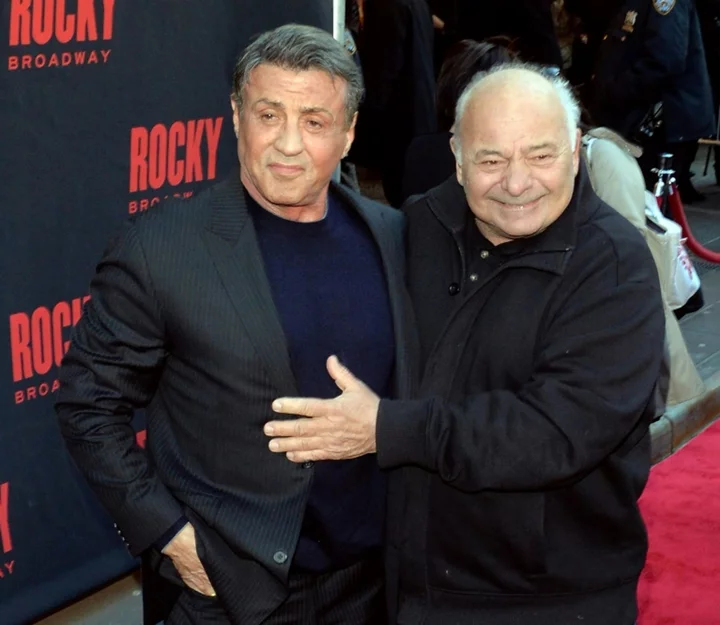There’s an emerging winner in the 2024 presidential contest: television broadcasters.
Spending on political advertising is estimated to reach a record $10.2 billion in the 2024 cycle, according to new projections from AdImpact, which tracks and analyzes spending. Local television stations are projected to rake in half — $5.1 billion — of that amount, maintaining their advertising dominance in an increasingly competitive media landscape.
Television consumption has changed drastically in recent years as more consumers are opting to ditch costly cable subscriptions in favor of a la carte streaming services, depriving local stations of revenue. Still, local broadcast station owners, including Nexstar Media Group Inc. and Hearst Television Inc., remain the biggest beneficiaries of political group spending.
Cable television trails broadcast with $1.9 billion of total spending, according to the AdImpact projections. Connected TV, which includes streaming services and devices, is likely to pull in $1.3 billion, while digital ads — namely those on Meta Platforms Inc.’s Facebook and Alphabet Inc.’s Google — could reach $1.2 billion. Radio accounts for $400 million, according to the estimates.
Political ad spending in the 2024 US election cycle has already reached $652 million, 75% more than at the same point in the last presidential campaign. This cycle will likely surpass the all-time high of $9 billion in the 2020 cycle, according to AdImpact.
Groups aligned with Republicans such as Florida Governor Ron DeSantis and South Carolina Senator Tim Scott, who are seeking to challenge former President Donald Trump for their party’s presidential nomination, are dishing out tens of millions of dollars in advertising this fall. President Joe Biden, who doesn’t face a serious primary challenger, has already run ads to draw attention away from major Republican campaign events, including the first GOP debate last month.
Nexstar, the largest owner of local television stations in the US, is even more bullish on political ad spending after what it said was a disappointing midterm cycle in 2022. It projects $11 billion in spending industry-wide.
“We are extraordinarily well-positioned to take share and dollars, both locally and nationally,” said then-Chief Operating Officer Tom Carter, now senior advisor, in an earnings call last month.
Nexstar has stations in key battlegrounds, including Pennsylvania, which will be home to a competitive Senate race and could likely be a deciding state in the presidential contest. The media group also has a presence in other important states in the presidential race, including Georgia, Michigan, North Carolina and Wisconsin.
Gray Television Inc., which owns stations in five television markets serving the early caucus state of Iowa, is already seeing twice as much ad revenue in the first half of 2023 than it did at the same point in 2019, the company told analysts last month. Gray Executive Vice President Jim Ryan said on an earnings call that those numbers are “unimaginable” for what’s supposed to be an off-year for political spending. But he declined to give an estimate for 2024 spending, saying only that it’s “going to be a large number.”
Television stations like political advertising because of the high margins. That’s especially true for ads placed by super political action committees that pay higher rates than the discounted airtime available to federal candidates.
Several Republican presidential contenders — including Trump, DeSantis and Scott — are relying on their allied super PACs to do a bulk of the advertising buying, because those groups can raise unlimited amounts of money, unlike their campaigns that have limits on how much they can accept from an individual donor.
Another boon for broadcasters is that political ads are paid in advance, allowing them to pay down debt.









